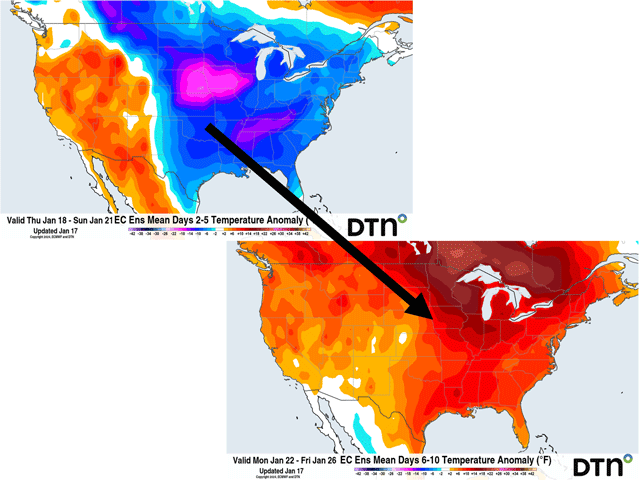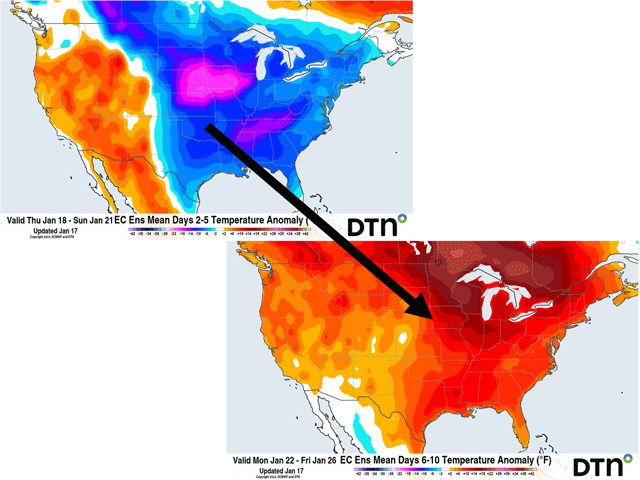Ag Weather Forum
Polar Vortex's Last Punch Before Return to Warmer Winter
Harsh, brutal, dangerous. Pick a word or use your own, the cold that has moved into and through much of North America during the last week has been brutal, and in some cases record-breaking. Only those in the Southwest and the southern tip of the Florida Peninsula have been spared from the arctic cold conditions due to visit from the polar vortex during the last seven-to-ten days.
The polar vortex describes the jet stream that circumnavigates the polar region. When it is displaced from its normal position, very cold air from the Arctic can be pushed southward into the mid-latitudes.
We are seeing another burst of strength from the polar vortex this weekend, but then see it quickly leave and be replaced by the type of warmth we had seen in December, or at least close to it.
An arm of the polar vortex has been circling around North America since early last week, but its harsh conditions made their presence known in Western Canada starting Jan. 10 and spread throughout much of the Northwest, Plains, and Midwest since. It took some time, but eventually the polar vortex made its way into the Southeast earlier this week.
P[L1] D[0x0] M[300x250] OOP[F] ADUNIT[] T[]
Though we saw a bit of moderation to the extreme cold midweek, the polar vortex has pushed another round of cold into the Plains and Midwest behind a clipper system that moved through Jan. 18-19 with some light to moderate snow. The cold will last through the weekend.
Temperatures will not be nearly as cold as the first round was, but another burst of below-zero-Fahrenheit lows could reach down as far south as the Ozarks for Saturday, and single digits above zero F could go as far south as northern Oklahoma and Alabama. The coldest air will come where the high-pressure center ends up on Saturday morning, forecast over Iowa and the adjacent areas (where morning lows could approach minus 20 F again), and Sunday morning, centered around eastern Kentucky (where low temperatures may fall close to zero F). High temperatures will only be slightly above zero F for the Northern Plains and Upper Midwest during the peak and areas in Tennessee may not break the 20-degree mark on Saturday.
Thankfully, this shot of arctic air will be brief. An upper-level ridge developing in the West will shove the polar vortex northeast through Canada during the weekend. The ridge will build quite significantly across most of North America but particularly across the eastern half of the continent for next week, dominating the pattern.
The ridge will usher in a quick change to higher temperatures starting on Jan. 21 in the Plains and Jan. 22 farther east. Temperatures may reach up to 40 degrees F as far north as Minneapolis and Detroit. Above- and well-above-normal temperatures will be in place for the entire week with the ridge settling in.
At the same time the ridge builds, a trough over the Pacific will squeeze a piece of itself into the Southwest this weekend, become cutoff, and get stuck around northern Mexico and Texas for next week. That should lead to flow from the Gulf of Mexico that will pump in not only heat but also heavy moisture.
Rainfall will be common in the Southern Plains and South-Central states for much of next week, coming in several waves up through the Northeast. Model forecasts for next week have a general 1.5 to 3 inches of rain from eastern Texas through the Tennessee Valley and the surrounding areas, with another inch or more for large sections of the southeastern Plains, Midwest, and Southeast.
Temperatures may be rising, but could still be cold enough for some wintry precipitation on the front end of the storm system Jan. 21-22. Pockets of freezing rain will be possible in the southeastern Plains up to the southern end of the Great Lakes. That will be questionable as temperatures will be borderline and rising. More certain is some cold-enough temperatures for snow farther north across the Great Lakes. Model forecasts are expecting some moderate to perhaps heavy snow from Iowa to Michigan yet again. Afterward, models are suggesting mostly rain.
This change to an overall ridge with an undercutting trough across the South is the pattern we were accustomed to experiencing in December and the first week of January, and a typical background feature during El Nino. Though snow cover is far more expansive now than it was back in December, which will put a lid on some of the warmth, a return to mild winter conditions is expected. This pattern likely continues through the last days of January, but there is potential for North America to see another shot of seasonably cooler air in early February. It does not look like the arctic blast we are currently in, but may bring in some break from the warmth. There are other indications of some cold weather moving in during mid-February as well, but all of these are just hints thus far. It will take some consistency in the models to gain any confidence on the potential return to cold weather.
To find more weather conditions and your local forecast from DTN, head over to https://www.dtnpf.com/…
John Baranick can be reached at john.baranick@dtn.com
(c) Copyright 2024 DTN, LLC. All rights reserved.






Comments
To comment, please Log In or Join our Community .